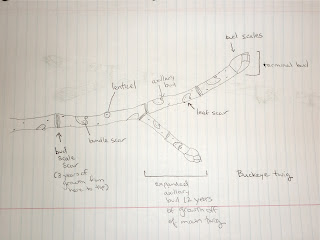Everyone knows that you can chop down a tree, count the rings in the wood and tell how old the tree is. Trees grow in spurts, usually one growth spurt per spring/summer, and they add a new layer of tree where the bark meets the wood. They add a new, microscopic layer of bark, and a layer of wood thick enough to count when the tree is cut down. More on bark and wood at this
previous post.
I bet you didn't know that you can figure out how old twigs are too, and you don't even have to cut them down to tell. Twigs have so much to say once you know how to read them. This post is best if you have a twig and a magnifying lens nearby, but in case you don't, I've included some fabulous drawings to help you. I hired a professional artist and spared no expense. Twig details are usually too small to photograph well, unless you have a buckeye twig which are out-sized and easy to see. I haven't found a buckeye in Chicago yet, so you'll have to make do with these drawings instead of photographs. All the parts I'll discuss here are visible on all twigs, but most are a little smaller.
 |
| Artist's rendering of a buckeye twig on archival-quality notebook paper. |
First, find the buds. Buds are live twig-tips covered in scales and protected to survive the winter. The end buds, called terminal buds, are at the ends of twigs, and they are usually the largest. If you cut open a terminal bud under a microscope, you would see layers of yet-to-be expanded leaves and stem material. In the spring, terminal buds grow long and send out leaves, extending the twig. There are also axillary buds, which grow just above every leaf a tree has (unless the tree is a sycamore, then axillary buds grow inside the leaf stem base). Axillary buds can expand into twigs and leaves too, but they are usually much smaller and less mature. They often only grow in spectacular growing seasons or if the terminal bud is cut off.
 |
| Buds - terminal and axillary |
In the winter, you can see scars on the twigs where previously-grown leaves have fallen off. Axillary buds are above the leaf scars. Buds are covered by bud scales, tough leaf-shaped brown things protecting the bud in winter. Bud scales fall off in the spring when the bud starts to grow, and they leave scars that encircle the twig in tiny, bunched lines. If you look back from the tip of a twig, you can find scars from last winter's bud scales.
 |
| Bud scales, bud scale scars and leaf scars. |
Since bud scales are produced each winter and fall off each spring, they leave annual scars on the twig. You can tell a twig's age by counting back from the tip of the twig and seeing how many sets of bud scale scars are present on the twig.
Twigs also have tiny dots on them called lenticels. If you zoomed in on a lenticel, you would see an opening with a tiny mouth-like structure that can actually open and close. The opening is called a stoma, and it is for allowing exchange of oxygen and carbon dioxide into the air - basically it allows the plant to breathe. You have probably heard of stomata (plural of stoma) on leaves before, and these are the same thing, just on bark instead.
 |
| Lenticels and age of twig |
The age of the whole twig can usually be determined by counting back from the longest branch. You can tell the age of side branches too, by counting the bud scale scars back from their tips. You can also tell how good the growing season was by the distance between bud scale scars. A good growing season will have a long distance between bud scale scars. A dry or cool year will have less growth.
Deer like to eat terminal buds off of edible trees because of the tender, living material inside. When that happens, axillary buds are activated, and often several side-branches will grow during the next summer. This can give a branch a bushy appearance. When you trim a branch by chopping off the end of it, the same thing happens. Whatever grows back will be bushier. If you trim off an entire side branch where it joins a larger branch, the next year's growth will not be bushier - instead the terminal bud elongates and the branch just gets longer. You can influence the shape your trees and bushes by trimming off side branches completely to encourage them to grow in the direction of the remaining terminal buds.
 |
| Twig life history |
|